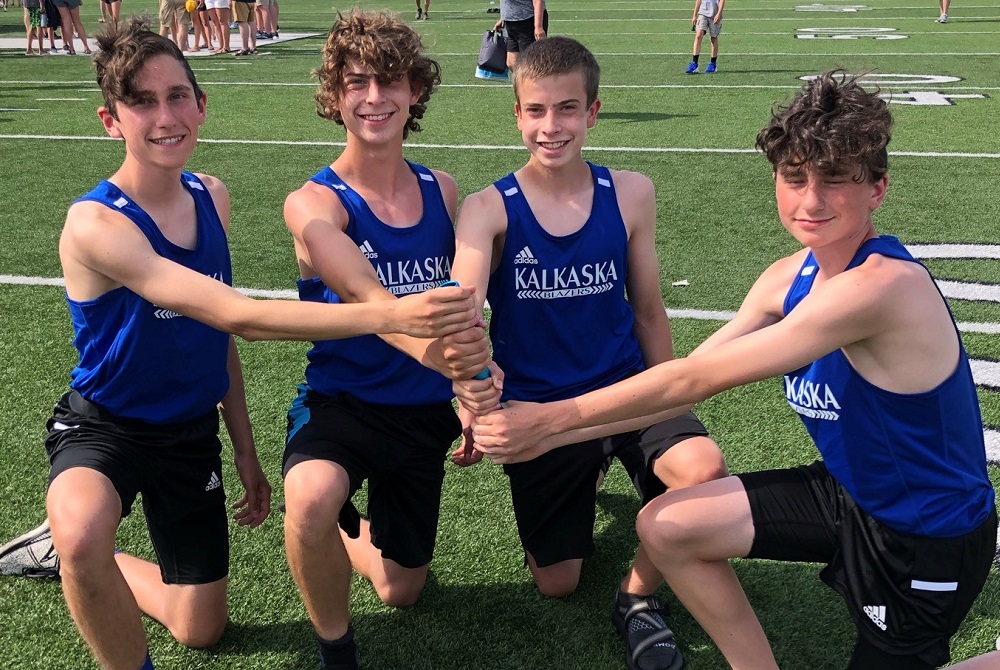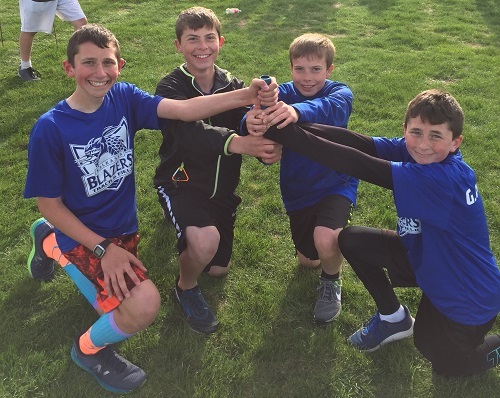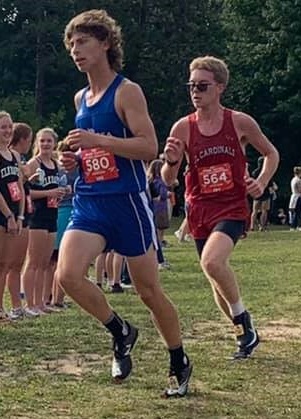
Brother Pairs Pace Kalkaska's Boys Cross Country Hopes
By
Tom Spencer
Special for MHSAA.com
September 10, 2021
Three sets of Kalkaska brothers will be running together again this weekend. And most likely Tyler Guggemos and Hayden Moore, both seniors, will be leading the Blazers.
 This time, they’re running in the mud – the Charlevoix Mud Run.
This time, they’re running in the mud – the Charlevoix Mud Run.
The Mud Run is held every year by the Charlevoix Rayders. It’s a favorite of most teams as they overcome obstacles and challenges while getting a little dirty in the process. With multiple knee-deep mud pits, logs and other obstacles strewn throughout the course, overcoming those are at least as important as racing opponents when it comes to achieving a good finish.
Many of the teams are Kalkaska’s opponents in Lake Michigan Conference races and possible obstacles for MHSAA Finals qualification. And East Jordan, a league opponent, also is hosting the Regional.
The Mud Run will help the Blazers along in meeting the season goals.
Guggemos and Moore hope to qualify for the Lower Peninsula Division 3 Finals at Michigan International Speedway in Brooklyn. They’ve set their sights on individual qualification but have high hopes the whole team will be there, including their younger brothers Gavin Guggemos and Camden Moore, and senior twins Jake Olds and Dave Olds.
“We would like to finish in the top half of the teams at the Lake Michigan Conference meet and take a shot at qualifying for the state finals,” said Kalkaska cross country coach Doug Brown, who has coached all the brothers since they started running middle school track. “We'd have to be in the top three finishers at Regionals to do that.
“We'd at least like to get two or more runners to the state finals.”
 Hayden Moore would love to reach the Finals with his younger brother coming along.
Hayden Moore would love to reach the Finals with his younger brother coming along.
“I really want to get sub-17 (minutes) for the 5K and get into states,” Hayden said. “I also really want to get our team to states.”
Tyler Guggemos, who has a shot this fall at breaking Kalkaska’s cross country school record, agreed.
“I would like to make it to the state cross country meet and be in the top five in the state,” he said. “It would be great if the team made it too!”
The Blazers are off to a good start competing in McBain, East Jordan and Benzie Invitational meets with Guggemos finishing first for Kalkaska and Moore second. Their younger brothers as sophomores round out the top four. The twin Olds brothers are also pushing them along.
There’s a little sibling rivalry helping the Blazers, the boys acknowledge, but none noted between the brothers. The six boys have been running for Kalkaska together for six years, starting on the middle school track.
“Dave and I have competed quite a lot over the years, as is natural for twins to do,” said Jake Olds. “I wouldn’t call it a rivalry because he and I have different interests and have different goals in running.
“Having a brother on the team is a gift and a curse because, well, we are brothers and it’s fun to spend time together, to an extent.”
Gavin Guggemos hopes to match his brother’s success.
“It's nice to have someone to try to chase,” he said. “It's not a rivalry because he makes me want to be better.
“It's fun to train together,” Gavin continued. “My goals this year are to run in the 17s and make it to states.”
The younger Moore views it similarly.
“It’s not really a competition, although it is fun to compare times and say that you’ll catch them,” Camden said. “When it comes to times it’s fun to try to beat his when he was in my grade.”
 Hayden finds motivation in his brother’s running.
Hayden finds motivation in his brother’s running.
“I think that it's a rivalry in that my brother races to beat my PR (personal record) at the same age and I race so that he can't beat my PR when he gets to my age,” he said. “We also have a rivalry over summer miles.”
The Guggemos and Moore brothers teamed up to run the 3,200 relay as sixth and eighth graders and then qualified for the Track & Field Finals in the 3,200 last spring as freshmen and juniors.
Brown is looking for even more success for all three pairs, but he remembers fondly the start in middle school track, especially the 3,200 relay team.
“I was very happy for them, because we thought they were a good team in middle school, and it was great to see them live up to their potential a few years later,” he said. “They were thrilled to be able to make a trip to the state meet together.”
Looking ahead, Kalkaska will host an invitational Sept. 21 after going to Elk Rapids on Sept. 16.
At Elk Rapids, the brother pairs will compete against Coach Brown’s son Seth, a sophomore. The Elks also have a brother duo – junior Caleb Kerfoot and sophomore Christian Kerfoot.
 Tom Spencer is a longtime MHSAA-registered basketball and soccer official, and former softball and baseball official, and he also has coached in the northern Lower Peninsula area. He previously has written for the Saginaw News, Bay County Sports Page and Midland Daily News. He can be reached at [email protected] with story ideas for Manistee, Wexford, Missaukee, Roscommon, Ogemaw, Iosco, Alcona, Oscoda, Crawford, Kalkaska, Grand Traverse, Benzie, Leelanau, Antrim, Otsego, Montmorency, Alpena, Presque Isle, Cheboygan, Charlevoix and Emmet counties.
Tom Spencer is a longtime MHSAA-registered basketball and soccer official, and former softball and baseball official, and he also has coached in the northern Lower Peninsula area. He previously has written for the Saginaw News, Bay County Sports Page and Midland Daily News. He can be reached at [email protected] with story ideas for Manistee, Wexford, Missaukee, Roscommon, Ogemaw, Iosco, Alcona, Oscoda, Crawford, Kalkaska, Grand Traverse, Benzie, Leelanau, Antrim, Otsego, Montmorency, Alpena, Presque Isle, Cheboygan, Charlevoix and Emmet counties.
PHOTOS: (Top) From left: Tyler Guggemos, Hayden Moore, Camden Moore and Gavin Guggemos make up two thirds of a Kalkaska distance running group with Cross Country Finals aspirations this fall. (Middle) Those four also filled relay spots together during middle school track. (Below) Hayden Moore (580) rounds a bend during a race. (Photos courtesy of the Kalkaska athletic department.)

MHSAA Vault: MIS Rose to Challenges to Host 2020 LP Finals
By
Rob Kaminski
MHSAA benchmarks editor
November 12, 2021
The “MHSAA Vault” features stories from past publications and other documents in the MHSAA Library. This issue takes a look at the MHSAA Cross Country Finals at Michigan International Speedway, which celebrated 25 years in 2020 – although it was an event that nearly didn’t happen last fall …
In 1996, the MHSAA and Michigan International Speedway began a partnership the changed the course of the Lower Peninsula Cross Country Finals – quite literally.
The land in and around the track at Brooklyn would host the Finals for all classes of runners in one place on one day, an annual festival of nearly 2,000 runners competing for the MHSAA’s top honors.
Even skeptics – and there were several among running purists who thought the course was too flat, for example – can’t deny the results.
Finals attendance nearly doubled in that first year, and crowds in excess of 10,000 have enjoyed a day of racing several times, including a record 12,153 in 2011.
Enthusiastic crowds were the norm in recent years, with 11,232 in 2017, and nearly 11,000 in 2018 (10,989) and 2019 (10,873).
In fact, attendance failed to reach at least 8,000 only twice since the move to MIS.
Of course, last year was an exception, when attendance was limited to 1,000 spectators per session due to the COVID-19 Pandemic. Fans also were restricted to the grandstands rather than following the action throughout locations on the course.
To reduce the number of runners in each race, the event was spread over two days, with each Division being run in two separate “sections” with times then combined at the end to determine team and individual champions.
While not ideal, the end result was another year of fantastic efforts at MIS – both from student-athletes and those behind the scenes.
“Even at the last hour, less than a week ahead of the Finals, we were closer to not having the Finals than we were to having them,” said MHSAA Assistant Director Cody Inglis, who coordinates the cross country postseason. “Rumors and challenges of mandated shutdowns, testing and other requirements were being discussed and caused a lot of unknowns. Even at the Regional level, we had schools, Regional courses and hosts shutting down their facilities; we had to relocate four Regionals 48 hours prior to race times. That scenario just could not happen at the Finals level where far more runners and much more travel would be involved.”
Among the many last-minute hurdles was the edict from NASCAR – which owns MIS – that all persons on site be temperature checked upon entry. That meant securing thermometers that were easy to operate in short order, along with personnel necessary to conduct the readings.
The attendance limitations certainly helped to implement the temperature screening, but brought their own issues.
“Limiting spectators was not a popular decision, but it really was the only way to have a race,” Inglis said. “We were taking direction and working with policies and protocols from the MDHHS, the Governor’s office, Lenawee County Health Department, MIS and NASCAR.”
Part of the solution was to utilize the grandstands as a “barrier” between participants and spectators. The reduced number of fans were dispersed over thousands of seats while still allowing them the chance to watch their student-athletes compete.
“It wasn’t the same, it wasn’t easy or perfect, but it was what we had to do to have a race,” Inglis said. “Separating the Finals into two days and different sections also allowed us to spread out the event and limit the number of people on site at any one time. This was a key part of the plan and worked well even though it separated races within a Division.”
The MHSAA, MIS and the cross country community never lost focus of the main goal: a culmination of the season for the student-athletes, who deserved something last year more than ever. And, more than ever, MIS once again displayed its advantage as a venue that could adapt to the fluid nature of the times to pull off the event.
“There were some thoughts of using four different sites, but as we learned during the Regionals, the climate of things was so tenuous from one area of the state to another that we couldn’t be 100-percent certain that there wouldn’t again be last-minute cancelations,” Inglis said. “MIS was wonderful to work and collaborate with, and was the best option to get it done. It was never mentioned once publicly about the possibility of not having the Finals – only how we could best do it under uncharted conditions.”
The moving parts and ever-changing scenarios created more complexity than ever in finalizing a season, but every decision was made with the complete desire to conduct the Finals as close to normal as possible.
“I firmly believe that a finish to the season, no matter the differences in race formatting and fan experience, was something everyone would have taken when the season began in August,” Inglis said.
Indeed, the finish line in Year 25 at MIS might have been the most gratifying of them all.

